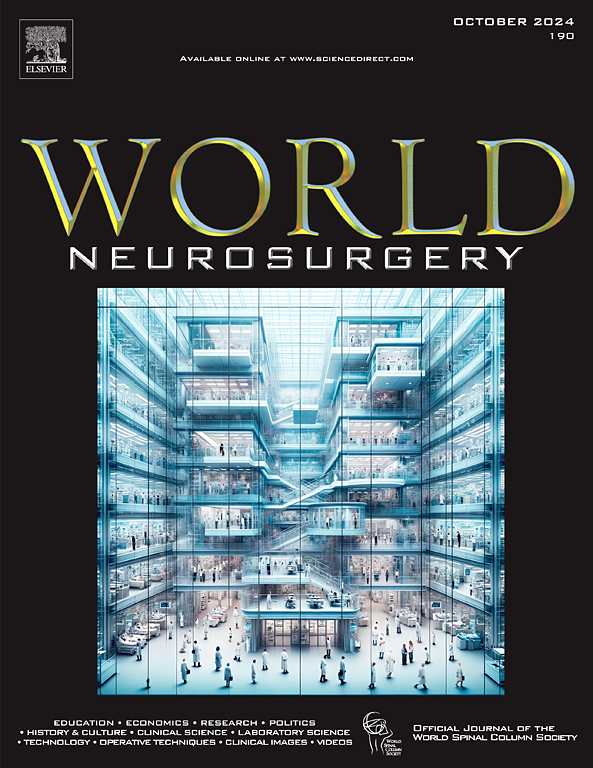Navigated Osteosynthesis for Unstable Atlas Fractures: Technical Note and Case Series
IF 1.9
4区 医学
Q3 CLINICAL NEUROLOGY
引用次数: 0
Abstract
Objective
Fractures of the atlas are typically considered stable or unstable based on the integrity of the transverse ligament. Whereas stable Jefferson burst fractures can be treated nonoperatively, unstable fractures with disruption of the transverse ligament often require surgical intervention. Atlas osteosynthesis has been proposed as a motion-preserving alternative to atlantoaxial fusion. Intraoperative navigation may facilitate safe placement of C1 instrumentation.
Methods
Cases of patients with unstable atlas fractures treated with navigated osteosynthesis at a single level I trauma center were identified and retrospectively reviewed. Clinical presentation, surgical management, and postoperative outcomes were assessed.
Results
Eight patients underwent navigated posterior atlas osteosynthesis for unstable C1 fractures between December 2015 and January 2024. All patients demonstrated injury to the transverse ligament (Dickman type I [n = 1] and type II [n = 7]). Patients were followed with serial radiographs showing preserved alignment, with no significant change in postoperative atlantodental interval at the most recent follow-up (+0.2 ± 0.87 mm [mean change ± standard deviation]; P = 0.53). Six patients obtained follow-up computed tomography, all of which demonstrated evidence of osseous union across fractures without hardware complication. No patients developed postoperative instability requiring fusion.
Conclusions
Atlas osteosynthesis is an attractive motion-preserving approach to the treatment of unstable atlas fractures, avoiding the morbidity of atlantoaxial fusion. Classically reserved for Jefferson fractures with Dickman type II transverse ligament injury, atlas osteosynthesis may also be a viable option for type I transverse ligament injuries. Intraoperative navigation can be particularly useful for screw placement in the setting of traumatically distorted anatomy with lateral mass displacement.
不稳定寰椎骨折的导航植骨术:技术说明和病例系列。
目的:基于横韧带的完整性,寰椎骨折通常被认为是“稳定”或“不稳定”。稳定型杰弗逊爆裂骨折可以非手术治疗,而不稳定型骨折伴横韧带断裂通常需要手术治疗。寰枢骨融合术已被提出作为一种保持运动的替代寰枢融合。术中导航可促进C1内固定的安全放置。方法:对在一级创伤中心行导航植骨术治疗不稳定寰椎骨折的病例进行回顾性分析。评估临床表现、手术处理和术后结果。结果:2015年12月至2024年1月,8例不稳定C1骨折患者行导航后路寰椎骨融合术。所有病例均表现为横韧带损伤(Dickman I型[n=1]和II型[n=7])。对患者进行系列x线片随访,显示保持对齐,在最近的随访中,术后寰齿间距无明显变化(+0.2±0.87mm[平均变化±SD], p=0.53)。6例患者随访CT,均显示骨折骨愈合,无硬体并发症。没有患者出现术后不稳定需要融合。结论:寰枢骨融合术是治疗不稳定寰枢骨折的一种有吸引力的保持运动的方法,避免了寰枢融合的发病率。传统上用于Jefferson骨折合并Dickman II型横韧带损伤,寰椎骨融合术也可能是治疗I型横韧带损伤的可行选择。术中导航对于外伤性解剖畸形伴侧块移位的螺钉置入尤其有用。
本文章由计算机程序翻译,如有差异,请以英文原文为准。
求助全文
约1分钟内获得全文
求助全文
来源期刊

World neurosurgery
CLINICAL NEUROLOGY-SURGERY
CiteScore
3.90
自引率
15.00%
发文量
1765
审稿时长
47 days
期刊介绍:
World Neurosurgery has an open access mirror journal World Neurosurgery: X, sharing the same aims and scope, editorial team, submission system and rigorous peer review.
The journal''s mission is to:
-To provide a first-class international forum and a 2-way conduit for dialogue that is relevant to neurosurgeons and providers who care for neurosurgery patients. The categories of the exchanged information include clinical and basic science, as well as global information that provide social, political, educational, economic, cultural or societal insights and knowledge that are of significance and relevance to worldwide neurosurgery patient care.
-To act as a primary intellectual catalyst for the stimulation of creativity, the creation of new knowledge, and the enhancement of quality neurosurgical care worldwide.
-To provide a forum for communication that enriches the lives of all neurosurgeons and their colleagues; and, in so doing, enriches the lives of their patients.
Topics to be addressed in World Neurosurgery include: EDUCATION, ECONOMICS, RESEARCH, POLITICS, HISTORY, CULTURE, CLINICAL SCIENCE, LABORATORY SCIENCE, TECHNOLOGY, OPERATIVE TECHNIQUES, CLINICAL IMAGES, VIDEOS
 求助内容:
求助内容: 应助结果提醒方式:
应助结果提醒方式:


